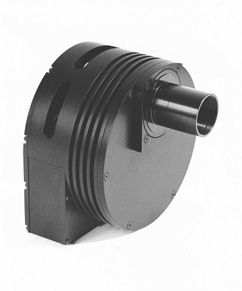 |
MODEL ST-9E |
Preliminary Specifications
---------------------
Comparison of Relative Sensitivity, FOV and Image Size
ST-9E, ST-7/8 ABG, ST-7/8E ABG
---------------------
 |
ST-9E
What you get with the new detector:
Sensitivity - (bigger pixels)
Field of View - much bigger FOV than ST-7,
almost as large as ST-8 - (bigger detector)
What you don't get with the new detector:
High resolution at short focal lengths -
(bigger pixels)
Larger image size on the monitor - (fewer
pixels)
What focal length should be used?
Large scopes, even those with relatively fast
f/ratios, have focal lengths that "waste" sensitivity of cameras using detectors
with small pixels. Take, for example, a C-14 at f/7, 16" SCT at f/6.3 and a
20" f/5. In all of these cases the telescopes have focal lengths of about 98 to
100 inches. When used at 100 inches of focal length, the 9 micron pixels of the ST-7
and ST-8 cameras subtend about 0.7 arcseconds - a bit small for this focal length.
So these cameras are often operated binned 2x2 at focal lengths of 100 inches or more
unless the optics and seeing are rather exceptional. For the ST-8 this is no problem
because the detector has 1.5 million pixels and binning 2x2 still leaves the user with a
reasonable 765 x 510 pixels @ 18 microns. But binning the ST-7 2x2 yields an image
that is 382 x 255 so the image size on the monitor begins to get small for this size
camera. However, the ST-9E's 20 micron pixels subtend about 1.6 arcseconds per pixel
at 100 inches focal length without binning. Just about perfect for typical seeing
conditions. This gives the user the advantage of larger more sensitive pixels and a
reasonably large image of 512 x 512. Moreover, when the FOV of the ST-9E is
nearly as large as an ST-8.
Sensitivity:
This section contains preliminary information obtained during our tests which demonstrates
the difference in sensitivity between the standard ST-7/8 ABG, the enhanced ST-7/8 ABG and
the enhanced ST-9E. The planetary nebula, M27, was imaged through the same
telescope, a C-11 at f/10, with each camera operating at the same temperature on the same
night. A single 5 minute image was taken with each camera. The table below
shows the relative increase in sensitivity over a standard ABG detector as measured in
various regions of the nebula as indicated on the color reference image. The numbers
in the chart shows the relative increase in counts obtained compared to a standard ST-8
ABG which is given a reference of "1" for the purposes of the comparison.
Although not a very rigorous test, this comparison nevertheless demonstrates in general
terms the differences in sensitivity between the three detectors. Caveat:
The ST-9E has 20 micron pixels and the ST-8 has 9 micron pixels. The ST-8s were not
binned for these tests. With its lower dark current, in 2x2 binned mode (18 micron
pixels) or 3x3 binned mode (27 micron pixels) the ST-8E camera's sensitivity will be
roughly equal to or exceed the ST-9E in unbinned mode. When time permits we will do
a similar comparision with an ST-8E in binned mode. The cameras all have similar
(but not identical) gain settings.
 |
Relative Intensities |
ST-8 ABG |
ST-8E ABG |
ST-9E NABG |
| (A) Background | 1 | 1.3 | 14.2 | |
| (B) Star peak (color unknown) |
1 | 2.0 | 13.7 | |
| (C), (D) H-a regions | 1 | 2.2 | 18.4 | |
| (E) OIII bright (~50% above background) |
1 | 2.1 | 25.0 | |
| (F) OIII faint (>10% above background) |
1 | 1.5 | 20.0 | |
| M27. LRGB color image for reference only by Robert Dalby |
Another way to compare the difference in sensitivity is to display the images taken with
the three cameras with the same range settings. The images below are displayed by
setting the background to similar black levels and then using the same range settings for
each of the three image files.
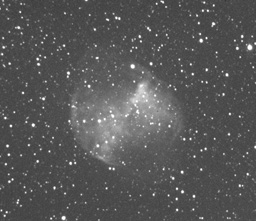 |
Image [1] M27. 5 minute image taken with standard ST-8 ABG through C-11 at f/10 Same display range as |
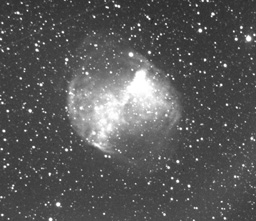 |
Image [2] M27. 5 minute image taken |
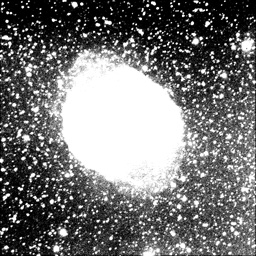 |
Image [3] M27. 5 minute image taken Same display range as |
Field of View:
The image below demonstrates the larger field of view one obtains with the ST-9E
detector compared to the ST-7. Note this has nothing to do with the number of pixels
on the detector or how the image is displayed on your computer monitor. Rather, it
is strictly based on the overall size of the detector.
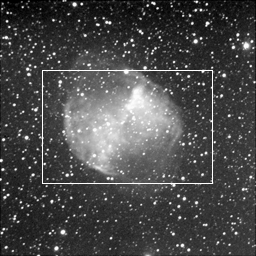 |
Full frame is the field of view of the ST-9E at 110 inches focal length. The area inside the white box is the field of view of the ST-7 at the same focal length. |
Image size on your monitor:
Unlike field of view, the size the image appears on your monitor depends on the number of pixels. So even though the ST-7 has smaller field of view than the ST-9E at a given focal length, images taken with the ST-7 will appear larger on the monitor because of the higher pixel count (765 x 510 vs. 512 x 512).
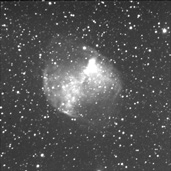 |
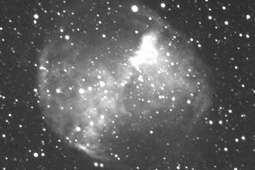 |
ST-9E image (left) and ST-7 image (right) both reduced 3X |
|
So even though the ST-9E image in the example above has a larger field of view, it will appear smaller on the monitor relative to an ST-7 image if the two are displayed at the same monitor resolution. However, monitor resolution or image size can be adjusted so that the images are shown at the same image scale as in the example below:
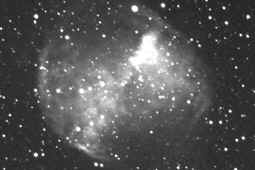 |
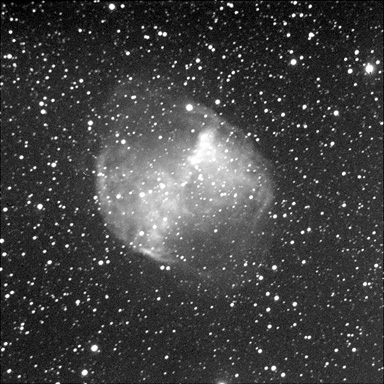 |
Top: Full frame ST-7E image reduced to 33% of full size |
Model ST-9E CCD Preliminary Specifications:
| CCD | Kodak Enhanced KAF-0261E (Class 1) + Texas Instruments TC-211 |
|---|---|
| Pixel Array | 512 x 512 pixels, 10.2 x 10.2 mm |
| Total Pixels | 262,144 |
| Pixel Size | 20 x 20 microns |
| Full Well Capacity | 180,000 e- |
| Dark Current | 35e¯/pixel/sec at 0° C |
| Antiblooming | Not available |
Readout Specifications
| Shutter | Electromechanical |
|---|---|
| Exposure | 0.11 to 3600 seconds, 10ms resolution |
| Correlated Double Sampling | Yes |
| A/D Converter | 16 bits |
| A/D Gain | 2.8e¯/ADU |
| Read Noise | 13e¯ RMS |
| Binning Modes | 1 x 1, 2 x 2, 3 x 3 |
| Full Frame Acquisition (including digitization and download) |
~ 11 seconds |
| Fast updates for focus (partial frame) |
~1.6 seconds |
Optical Specifications (8" f/10)
| Field of View | 17.3 x 17.3 arcminutes |
|---|---|
| Pixel Size | 2 x 2 arcseconds |
System Specifications
| Cooling | Two Stage Thermoelectric Active Fan Water Assist Ready -40 degrees C from Ambient Minimum |
|---|---|
| Temperature Regulation | ±0.1°C |
| Power | 5 VDC at 1.5 amps, ±12 VDC at 0.5 amp -------------------------------- 110VAC desktop power supply included -------------------------------- 12VDC power supply optional |
| Computer Interface | Standard Parallel Port |
| Computer Compatibility | PC - MS-DOS, Windows 95/98, Macintosh With Optional MAC SCSI adapter |
| Guiding | Dual CCD Self-Guiding |
Physical Dimensions
| Optical Head | 5 inches diameter x 3 inches 12.5 cm diameter x 7.5 deep 2 pounds/0.9 Kg |
|---|---|
| CPU | All electronics integrated into Optical Head, No CPU |
| Mounting | T-Thread, 1.25" and 2" nosepieces included |
| Backfocus | Approximately 0.9
inches 2.3 cm |
Price
Price |
$3950 |
|---|
Revised: October 21, 1999 09:47:37 AM.
Copyright © 1998 Santa Barbara Instrument Group, Inc. All rights reserved.
Please report any problems with this page directly to the Webmaster